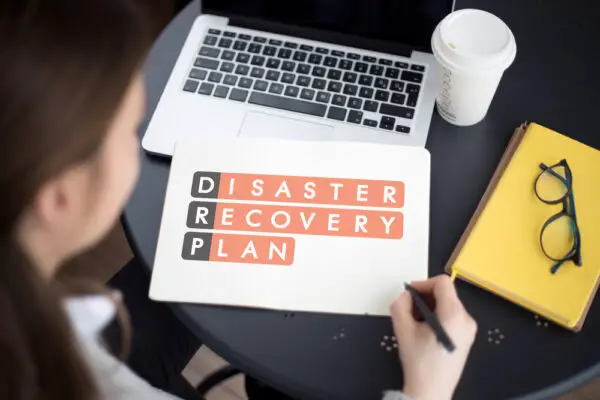Business Continuity and Disaster Recovery (BCDR) is a strategy for keeping a business running during bad times and quickly rebounding.
It’s about creating plans to mitigate risks, keep key operations running during a crisis, get IT systems back up quickly, and minimize downtime after an outage.
BCDR is a safety net for your business’s reputation, revenue, and stakeholder trust. It’s all about resilience and preparation. As you dive deeper into BCDR, you’ll learn about the components, execution, and benefits that can make a big difference to your business’s survival and continuity.
Quick Facts
- Business Continuity and Disaster Recovery (BCDR) are part of an organization’s risk management framework.
- BCDR is about keeping operations running during a crisis and getting IT systems back up quickly after an outage.
- Business continuity planning involves preserving critical operations and managing risks, while disaster recovery involves getting IT systems back up and running.
- BCDR is key to business resilience, minimizing downtime during unexpected events, and reputation protection.
- BCDR is about identifying threats, assessing risk, and developing risk mitigation strategies for business continuity and disaster management.
Business Continuity and Disaster Recovery
Business Continuity and Disaster Recovery (BCDR) are part of any organization’s risk management strategy.
Business continuity is about keeping critical operations running during a crisis; disaster recovery is restoring critical IT systems.
Understanding the relationship between these two can help with business resilience and minimizing downtime during unexpected events.

Definition and importance of business continuity and disaster recovery
BCDR is often the lifeline that keeps an organization afloat after a bad event, whether a natural disaster, pandemic, or cyber attack.
BCDR is a set of practices that keeps your organization running after a bad event.
Business continuity is about keeping your organization’s critical operations running during a crisis. It’s about planning and risk management – ensuring you have the strategies to mitigate potential disruptions to your operations. When threats arise, resilience becomes key.
On the other hand, disaster recovery is about restoration. It’s about getting your IT systems, applications, and data back up and running after a disaster. The goal is to minimize the impact on your business operations.
Whether you’re big or small, the increasing reliance on digital technologies means BCDR is a must. It’s a proactive and reactive measure part of your organization’s risk management framework.
BCDR is all about business continuity and minimizing downtime during disasters.
Business continuity and disaster recovery connection
Business continuity and disaster recovery may seem separate, but they’re often connected, each playing a critical role in ensuring your business can weather any storm.
Think of your business continuity strategy as the umbrella under which your disaster recovery plan sits.
Business Continuity Planning: This is about running your business during a crisis. It involves a business impact analysis to identify critical business functions that must be prioritized for recovery.
It’s about ensuring your business can keep running despite a natural disaster or other disruptions.
Disaster Recovery Plan: This is part of your business continuity planning. It’s about your IT systems, data protection, and system recovery after a disruption.
Continuity and Disaster Recovery: This overlaps your business continuity and disaster recovery strategies. They work together to keep your business resilient, minimize downtime, and get back up and running after a disruption.
In short, business continuity and disaster recovery are two sides of the same coin, both essential to a business’s survival.
Business Continuity Planning is important
If you work in Business Continuity and Disaster Recovery, you need to understand the value of business continuity planning.
You’ll find it’s not just about surviving a disaster but also about operational and business continuity and minimizing financial loss.
You risk your business without a plan, so let’s examine the benefits and consequences.
Benefits of having a business continuity plan
A solid business continuity plan will strengthen your organization’s resilience and enable you to navigate and recover from disruptions.
It’s a proactive approach to running critical processes, minimizing downtime, and recovering after a potential disaster beforehand.
In disaster recovery planning, you set your recovery point objective, the maximum amount of data that can be lost from an IT service in case of a major incident.
Here are three benefits of having a business continuity plan:
- Risk Mitigation: It helps you identify potential threats and develop strategies to minimize the impact if they occur. This could be natural disasters, cyber-attacks, or system failures.
- Business Resilience: A business continuity plan enables you to bounce back from disruptions and keep your operations running with minimal disruption.
- Reputation Protection: This protects your brand and customer relationships by showing that you’re prepared for anything, keeping your business’s reputation intact.
In short, a well-crafted business continuity plan is a safety net that allows your business to continue operating despite adversity.
Consequences of not having a business continuity plan
Despite the clear benefits of a business continuity plan, let’s look at the consequences of not having one. If a disaster strikes, the immediate concern for many organizations is downtime. Unplanned downtime can mean a significant loss of revenue.
You’ll also lose customers who rely on your services and products. They may go to your competitors, and that’s more revenue lost.
Investors want to back organizations that are prepared for contingencies. Without a business continuity plan, you risk losing their trust and, therefore, their funding.
Also, a lack of a plan can lead to compliance breaches. Many industries require a plan, and not having one can result in heavy fines and penalties.
Finally, consider the cost of reputation repair. Restoring your organization’s reputation after a disaster can be a tough task. Customers, investors, and the general public will lose confidence in you.
Having a business continuity plan will help you avoid all this.
Business Continuity and Disaster Recovery scenarios
You’ve seen why BCDR is important to your business.
Now let’s look at the scenarios, like natural disasters and power outages, cyber-attacks and IT failures, public health crises and physical security threats.
Knowing each situation will help you develop business continuity and disaster recovery strategies.
Natural disasters and power outages
When faced with natural disasters like severe weather events, earthquakes, or wildfires, your business operations will be disrupted, and power outages due to equipment failure or grid overload will compound the problem.
You need business continuity plans and disaster recovery strategies to minimize the impact and get back to business as usual as soon as possible.
- Business Continuity Plans: Proactive measures to keep critical operations running during a disruption. Focus on risk assessments and emergency management to avoid total shutdowns.
- Disaster Recovery Strategies: Reactive measures to get your IT infrastructure and data back up and running after a disaster. Aim to minimize data loss and return to business as usual as soon as possible.
- Power Outages can be natural disasters or equipment failures and cause significant business disruption. Part of your BCDR planning should be quickly managing and recovering from power outages.
Cyber attacks and IT outages
Understanding how business continuity and disaster recovery (BCDR) scenarios can protect your business operations is crucial to addressing growing cyber threats and potential IT outages.
Cyber attacks can pose a significant risk to your IT systems and cause disruptions that can shut down your business. Hardware failures and software flaws can also cause unexpected IT downtime. Human error, often overlooked, can bring your systems to a standstill.
Business continuity and disaster recovery (BC/DR) strategies are your safety net. They provide a plan to keep operations running during a cyber attack or IT outage and a path to recovery afterwards. With BC strategies, you can keep critical functions running and minimize the impact of disasters on your business.
Meanwhile, DR strategies focus on getting your IT systems back up and running, fixing software flaws, replacing failed hardware, and correcting human error.
It’s a complex dance, but you can’t afford to get it wrong. Investing in BC/DR strategies will prevent big losses and keep your business resilient to cyber threats and IT outages.

Public health crises and physical security threats
Just like cyber threats and IT outages can stop your business, public health crises and physical security threats can bring operations to a standstill.
These crises, whether pandemics, regional disease outbreaks, or bioterrorism, threaten public relations, staff health, and business continuity.
Physical security threats like workplace violence or civil unrest can cause property damage, injuries, or even loss of life.
To mitigate these threats, a BCDR plan is crucial. This plan should include:
- A risk assessment to identify and evaluate potential threats and their impact.
- A crisis management strategy to respond to different scenarios.
- Strategies to keep critical business functions running and get back to business as usual as soon as possible after a disaster.
Supply chain disruptions and other scenarios
Supply chain disruptions caused by geopolitical events, pandemics, or transportation issues can be just as disruptive as active shooter incidents. These events create supply chain bottlenecks that can impact your business flow.
A business continuity and disaster recovery (BC/DR) plan can be a lifesaver. It’s designed to keep your business running during these times and minimize the impact on your profit.
Think about geopolitical events. They can bring sudden policy changes and transportation disruptions. Pandemics can shut down entire industries and cause severe supply chain disruptions. Active shooter incidents may be rare, but they can threaten human life and business operations.
All these scenarios highlight the need for BCDR strategies. Your plan should cover all possible disruptions, prepare for them, and have a recovery process. It’s not just about surviving the disruption but bouncing back stronger.
Business Continuity Plan
When developing your Business Continuity Plan (BCP), you must clearly define your goals and objectives. This means identifying key components like communication plans and risk assessments.
You’ll also need to conduct a business impact analysis (BIA) to understand how potential disruptions will impact your business fully.
Goals and objectives of a business continuity plan
When creating a business continuity plan (BCP), your main goal isn’t just to recover data; it’s to minimize the impact of the crisis on your business and get your organization back up and running.
Your BCP, combined with a well-thought-out disaster recovery plan (DRP), is your best defense against unexpected disasters that can stop your business.
In short, your BCP should focus on the following:
- Minimize Downtime: Your plan should detail how to reduce downtime and get back to business as usual as soon as possible.
- Protect Data: Your DRP kicks in here and outlines how to back up and recover critical business data from all types of disasters.
- Minimize Reputational Damage: A good BCP will maintain stakeholder trust and confidence and minimize reputational damage during crisis management.
Don’t forget to ensure business continuity and training is a key part of your organization’s ability to execute your BCP.
With a good BCP and DRP, you’ll be able to do business, protect data, and manage any crisis that comes your way.
Business continuity plan components
Creating a business continuity plan (BCP) requires a thorough examination of the following critical components:
Your BCP should detail specific procedures and instructions during a disruption to minimize downtime and preserve your business, assets, and people.
Remember to include your business partners in the plan. They’re often overlooked but can be critical to your business continuity during a crisis. Consider how a disruption to their business will impact yours, and plan for that scenario.
Risk mitigation is another key component. This means identifying risks to your business and creating proactive strategies to reduce or eliminate those risks. Protect your assets and resources from potential threats and include those in your BCP.
How to do a business impact analysis (BIA) and risk assessment
To create a business continuity plan, you need to do a business impact analysis (BIA) and risk assessment, which are two essential steps that will help you identify your critical business processes and assess the impact of threats on your business.
A BIA is the foundation of your business continuity plan. It identifies critical business processes and systems that a disruption will severely impact.
Your BIA should answer questions like, ‘What are the consequences of a system shutdown?’ or ‘How long can we survive without this process?’
A risk assessment examines your business to determine threats’ probability and impact. This risk analysis will help you identify the threats that pose the greatest risk to your business.
In short:
- Do a BIA to identify critical business processes and systems.
- Do a risk assessment to assess the likelihood and impact of threats.
- Use that to shape your business continuity plan, so your business can ride any storm.
Disaster Recovery Plan
The first step in creating a Disaster Recovery Plan should be identifying your business’s critical processes and systems.
Once you’ve done that, you can start building a disaster recovery strategy.

Identifying critical business processes and systems
In a Disaster Recovery Plan, you must identify the business critical functions, business processes, and systems that are key to your business. These critical functions are essential to your business’s operating ability after a disaster.
First, you’ll need to identify key systems and determine critical processes. This means understanding your business and the dependencies between systems and processes.
Next, identify a recovery time objective (RTO) for each process and system. The RTO is the maximum time your system can be down.
Disaster recovery strategy
Developing your organization’s disaster recovery plan is a critical step that outlines what to do during a crisis, including data backup, system restoration, and stakeholder communication procedures.
This is a key part of business continuity and disaster management. It’s all about preparing for the next unexpected event so your business can survive and thrive, whatever happens.
Your disaster recovery plans need to cover data storage and recovery strategies. If your technology infrastructure fails, you’ll need to retrieve and restore data from backup systems quickly.
Each team member should know their part in these procedures to act quickly in a crisis.
Remember, the plan must be developed and tested regularly. This will ensure it works when you need it most.
Senior management should be involved in the planning process. Their input and guidance will help refine the strategy to align with the business goals.
Disaster recovery plan
So, how do you create a disaster recovery plan to ride any storm? First, you need to define disaster recovery in the context of your business. What disasters could hit, and how would they impact your operations?
Your disaster recovery plan (DRP) is part of a broader business continuity plan (BCP) and should focus on minimizing operational downtime and financial loss.
- Identify and assign roles and responsibilities: Clearly outline who does what during and after a disaster. This will ensure a coordinated response.
- Define recovery objectives: Establish your recovery time objective (RTO) and recovery point objective (RPO). RTO is the time it takes to get back up and running after a disruption, and RPO is the time you need to recover data.
- Establish communication strategy: Communication is key during a crisis. Who communicates what to whom and how?
And don’t forget testing. Use different testing methods to test your DRP regularly and refine it as needed.
Implementing and Testing
Now that you have your Business Continuity and Disaster Recovery (BCDR) plan, it’s time to put it to the test.
Implementation and testing are key to ensuring your plan is robust and can handle real-world disruptions.
We’ll examine the importance of testing, the different types of testing, and how to promote support and awareness within your organization.
Why testing a business continuity plan
To ensure the effectiveness of your business continuity plan, you need to test it regularly, using simple discussion-based tabletop exercises or full-scale simulations.
Testing gives you confidence that your recovery procedures will work as planned and will keep your business running when disaster strikes.
The importance of testing your business continuity plan can’t be overstated. Let’s look at it in context:
- Identifies Weaknesses: Testing will identify gaps and weaknesses in your plan. This will allow you to fix them so your business is fully prepared for disruptions.
- Builds Confidence: Regular testing will give you, your employees, and your stakeholders the confidence your business can ride any storm. This will boost morale and give you a sense of security.
- Ensures Compliance: Many industries have regulations requiring businesses to have a tested continuity plan. Regular testing will help you meet those regulations.
Types and frequency of testing
Now that you understand the importance of testing your business continuity plan let’s look at the types of tests you can do and when to do them to ensure your plan is robust and effective. Testing methods include tabletop exercises, walk-throughs, and simulations.
Tabletop exercises are group discussions based on a scenario that identify gaps in your business continuity plan (BCP) and disaster recovery plan (DRP).
Walk-throughs are a step-by-step review of the plan to ensure each procedure is understood and achievable.
Simulations are the most detailed, real-life disaster to test your BCP and DRP.
Timing is also important. You should test your BCP and DRP 2-4 times a year. This will allow you to adapt to and recover from unexpected events and keep your business running.
How to promote business continuity plan support and awareness
To successfully implement and test your business continuity plan, you need the full support of top management.
They must be involved in creating and updating the plan and also make time for its review and testing. This top-down approach will ensure your plan doesn’t just exist on paper but is communicated and executed.
Leadership Engagement: Leaders must be involved in creating and updating the plan. Their involvement will raise awareness and commitment to the plan across the organization.
Dedicated Time: Senior management must review and test the plan. This will show that the organization prioritizes it and is ready for disruptions.
Regular Testing and Updating: The plan should be updated regularly to address changing risks and business requirements. Regular testing will give you confidence in the plan and identify areas for improvement.
Business Continuity and Disaster Recovery Management
Understanding the roles and responsibilities of a BCDR management team is key to an effective business continuity and disaster recovery plan.
This team will implement the strategies to keep operations running and IT systems up after a disruption.
They will also manage the costs and resources for BCDR to ensure your organization is resilient without overspending.
Roles and responsibilities of a BCDR management team
If you are part of a BCDR management team, your role is to build, manage, and execute a BCDR plan with diverse stakeholders across the organization.
You will implement the Business Continuity Plan (BCP) and Disaster Recovery Plan (DRP). Your role is critical as your expertise will keep the organization running smoothly no matter what.
As a BCDR management team member, you will:
- Build a detailed BCDR plan, including identifying potential risks, assessing their impact, and developing mitigation strategies.
- Manage the execution of the BCDR plan. This includes coordinating with stakeholders, conducting cross-functional communication, and overseeing the plan’s implementation.
- Review and update the BCDR plan regularly to address organizational or environmental changes.
Managing BCDR costs and resources
Navigating the complexities of BCDR management and effectively managing costs and resources is critical to your role. Having a business continuity plan (BCP) and disaster recovery plan (DRP) is not just about implementing BCDR plans.
Managing BCDR costs and utilizing the required resources is key.
Building a BCDR strategy requires cost analysis and resource allocation. Identifying and prioritizing the resources required for each phase of your BCP and DRP is key.
This way, you are managing BCDR resources and ensuring they are invested where they will have the greatest impact.
View new BCDR capabilities as an investment, not an expense. Changes in the threat landscape or new business ventures may require your organization to extend its BCDR coverage. When this happens, prepare an investment proposal based on a solid business case highlighting the benefits the new capabilities will bring.
Best Practices and Standards for BCDR
Now, you can move on to the best practices and standards for BCDR.
This includes BCDR software and services, business continuity and disaster recovery plan templates, and industry standards.
This will help you build a robust and compliant BCDR plan.
BCDR software and services
Specialist BCDR software and services are the keys to your organization’s resilience strategy, helping you navigate the complexities of business continuity and disaster recovery.
These tools provide a whole business approach to managing disruptions beyond traditional methods.
- BCDR software:
Software specifically designed to help with your BCDR planning. It simplifies tasks like Business Impact Analysis (BIA) and risk assessment so you can build robust business continuity and disaster recovery plans. - Incident response capabilities:
BCDR software isn’t just about planning. It also has incident response capabilities so your organization can respond quickly and effectively when a disaster hits. - BCDR services:
External BCDR services can support your organization’s continuity. They bring expertise and experience where you may not have resources or knowledge.
Business continuity and disaster recovery plan templates
Having the right BCDR software and services in place is a good start, but consider using business continuity and disaster recovery plan templates to strengthen your planning.
These templates will help you build business continuity plans (BCP) and disaster recovery plans (DRP), key components of a comprehensive BCDR strategy.
Business continuity vs disaster recovery plan is a broad term that covers several methods throughout your planning.
A BCP involves maintaining normal operations during a disruption, while a DRP involves restoring IT systems and data after a disaster.
These templates will help you outline the procedures for preparing and responding to potential business disruptions. They provide a structured approach to identifying threats, assessing impact, and outlining the steps to get back up and running.
These templates will simplify your BCDR planning process and allow you to slot them into your overall risk management framework.

Industry standards and best practices for BCDR planning
When it comes to BCDR planning, look at the industry standards and best practices of government and private sector standards bodies like NIST and ISO.
These organizations provide detailed BCDR guidelines that provide a framework for building effective BCDR plans.
Here are three key components that these standards highlight:
- Risk Assessment involves identifying threats and assessing their impact on business continuity. You need to understand the risks your business faces to develop mitigation strategies.
- Business Impact Analysis (BIA): This process identifies critical business functions and determines the resources required to keep them running. It helps prioritize recovery in the event of a disaster.
- Testing and Maintenance: Validating BCDR plans requires regular testing. It’s also important to update these plans as your business changes and new risks emerge.
Conclusion: Protect Your Business with BCDR
In summary, it’s clear business continuity and disaster recovery are crucial for your business. A BCDR plan could be the difference between disaster recovery and business continuity during disruptions.
Let’s finish with some final tips to make your BCDR plan work.
Summary of business continuity and disaster recovery
Understanding business continuity and disaster recovery is key to your organization’s survival and success in our uncertain business world.
A Business Continuity Plan (BCP) and Disaster Recovery Plan (DRP) are key components of a BCDR strategy. They will ensure your organization can withstand any disruptive event, reduce impact, and get back up and running quickly.
So why are BCP and DRP important?
- Risk Mitigation: BCP identifies threats so you can implement mitigations. This means continuity during disruptions.
- Impact Reduction: DRP reduces the impact of a disaster. It provides a roadmap to get your IT systems and critical applications back up and running quickly, minimizing downtime.
- Resilience and Recovery: BCP and DRP are the foundation of your BCDR strategy. They will get your business back up and running after a disaster with minimal impact on your bottom line.
Tips for making your BCDR plan work
Now that you understand the importance of business continuity and disaster recovery let’s finish with some tips on making your BCDR plan work so your business is protected and resilient.
Your business continuity plan (BCP) should cover all potential disruptions to keep the business running continuously. A good BCP prepares, responds to, and recovers from disruptions, providing strategic and tactical capability.
Your disaster recovery plan (DRP) is important. Business continuity keeps operations running smoothly, and a disaster recovery plan gets the business back up and running after a crisis.
To ensure the effectiveness of your BCDR plan, use multiple testing methods throughout its life cycle, testing and updating for changes in your business or the external environment.
Allocate sufficient resources and budget to your BCP and DRP. These are not one-off efforts but ongoing commitments to your business.

Chris Ekai is a Risk Management expert with over 10 years of experience in the field. He has a Master’s(MSc) degree in Risk Management from University of Portsmouth and is a CPA and Finance professional. He currently works as a Content Manager at Risk Publishing, writing about Enterprise Risk Management, Business Continuity Management and Project Management.

